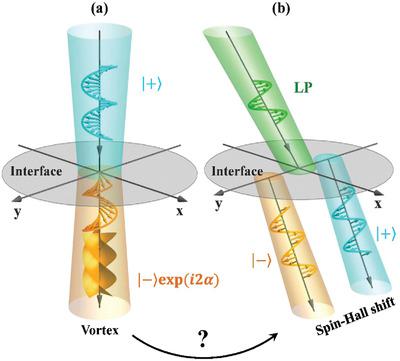当前位置:
X-MOL 学术
›
Laser Photonics Rev.
›
论文详情
Our official English website, www.x-mol.net, welcomes your feedback! (Note: you will need to create a separate account there.)
Topology-Induced Phase Transitions in Spin-Orbit Photonics
Laser & Photonics Reviews ( IF 11.0 ) Pub Date : 2021-05-11 , DOI: 10.1002/lpor.202000492 Xiaohui Ling 1, 2 , Fuxin Guan 1 , Xiaodong Cai 3 , Shaojie Ma 1 , He‐Xiu Xu 1, 4 , Qiong He 1, 5 , Shiyi Xiao 3 , Lei Zhou 1, 5
Laser & Photonics Reviews ( IF 11.0 ) Pub Date : 2021-05-11 , DOI: 10.1002/lpor.202000492 Xiaohui Ling 1, 2 , Fuxin Guan 1 , Xiaodong Cai 3 , Shaojie Ma 1 , He‐Xiu Xu 1, 4 , Qiong He 1, 5 , Shiyi Xiao 3 , Lei Zhou 1, 5
Affiliation

|
Spin-controlled vortex generation and spin-Hall effect, two distinct effects discovered in optics, have been extensively studied recently. However, while physical origins of two effects are both due to spin-orbit interactions, their inherent connections remain obscure which also hinders further explorations on the manipulations of them. Here, in studying the scattering of a spin-polarized light beam at sharp interfaces, an intriguing phase transition between vortex generation and spin-Hall shift trigged by varying the incidence angle is revealed. After reflection/refraction, the beam contains two components: normal and abnormal modes acquiring spin-redirection-Berry phases and Pancharatnam–Berry phases, respectively. Inside the abnormal beam, two classes of wave components gain Pancharatnam–Berry phases with distinct topological natures, generating intrinsic and extrinsic orbital angular momenta (OAM), respectively. Enlarging incidence angle changes the relative portions of these two contributions, making the abnormal beam undergo a phase transition from vortex generation to spin-Hall shift. Such intriguing effect is experimentally observed at a purposely designed metamaterial slab, exhibiting efficiency enhanced by several-thousand times compared to that at a conventional slab. These findings unify two previously discovered effects in a single framework, reinterpret previous results with clearer pictures, and shed light on understanding other physical effects involving the competition between intrinsic and extrinsic OAM.
中文翻译:

自旋轨道光子学中的拓扑诱导相变
自旋控制的涡流生成和自旋霍尔效应是光学中发现的两种不同的效应,最近得到了广泛的研究。然而,虽然两种效应的物理起源都是由于自旋轨道相互作用,但它们的内在联系仍然模糊不清,这也阻碍了对它们的操纵的进一步探索。在这里,在研究尖锐界面处自旋偏振光束的散射时,揭示了涡旋产生和通过改变入射角触发的自旋霍尔位移之间有趣的相变。反射/折射后,光束包含两个分量:分别获得自旋重定向-Berry 相位和 Pancharatnam-Berry 相位的正常模式和异常模式。在异常光束内部,两类波分量获得具有不同拓扑性质的 Pancharatnam-Berry 相位,分别产生内在和外在轨道角动量(OAM)。增大入射角会改变这两种贡献的相对部分,使异常光束经历从涡旋产生到自旋霍尔位移的相变。这种有趣的效果是在特意设计的超材料平板上通过实验观察到的,与传统平板相比,其效率提高了数千倍。这些发现将先前发现的两种效应统一在一个框架中,用更清晰的图片重新解释了先前的结果,并阐明了理解涉及内在和外在 OAM 之间竞争的其他物理效应。使异常光束经历从涡旋产生到自旋霍尔位移的相变。这种有趣的效果是在特意设计的超材料平板上通过实验观察到的,与传统平板相比,其效率提高了数千倍。这些发现将先前发现的两种效应统一在一个框架中,用更清晰的图片重新解释了先前的结果,并阐明了理解涉及内在和外在 OAM 之间竞争的其他物理效应。使异常光束经历从涡旋产生到自旋霍尔位移的相变。这种有趣的效果是在特意设计的超材料平板上通过实验观察到的,与传统平板相比,其效率提高了数千倍。这些发现将先前发现的两种效应统一在一个框架中,用更清晰的图片重新解释了先前的结果,并阐明了理解涉及内在和外在 OAM 之间竞争的其他物理效应。
更新日期:2021-06-11
中文翻译:

自旋轨道光子学中的拓扑诱导相变
自旋控制的涡流生成和自旋霍尔效应是光学中发现的两种不同的效应,最近得到了广泛的研究。然而,虽然两种效应的物理起源都是由于自旋轨道相互作用,但它们的内在联系仍然模糊不清,这也阻碍了对它们的操纵的进一步探索。在这里,在研究尖锐界面处自旋偏振光束的散射时,揭示了涡旋产生和通过改变入射角触发的自旋霍尔位移之间有趣的相变。反射/折射后,光束包含两个分量:分别获得自旋重定向-Berry 相位和 Pancharatnam-Berry 相位的正常模式和异常模式。在异常光束内部,两类波分量获得具有不同拓扑性质的 Pancharatnam-Berry 相位,分别产生内在和外在轨道角动量(OAM)。增大入射角会改变这两种贡献的相对部分,使异常光束经历从涡旋产生到自旋霍尔位移的相变。这种有趣的效果是在特意设计的超材料平板上通过实验观察到的,与传统平板相比,其效率提高了数千倍。这些发现将先前发现的两种效应统一在一个框架中,用更清晰的图片重新解释了先前的结果,并阐明了理解涉及内在和外在 OAM 之间竞争的其他物理效应。使异常光束经历从涡旋产生到自旋霍尔位移的相变。这种有趣的效果是在特意设计的超材料平板上通过实验观察到的,与传统平板相比,其效率提高了数千倍。这些发现将先前发现的两种效应统一在一个框架中,用更清晰的图片重新解释了先前的结果,并阐明了理解涉及内在和外在 OAM 之间竞争的其他物理效应。使异常光束经历从涡旋产生到自旋霍尔位移的相变。这种有趣的效果是在特意设计的超材料平板上通过实验观察到的,与传统平板相比,其效率提高了数千倍。这些发现将先前发现的两种效应统一在一个框架中,用更清晰的图片重新解释了先前的结果,并阐明了理解涉及内在和外在 OAM 之间竞争的其他物理效应。


























 京公网安备 11010802027423号
京公网安备 11010802027423号